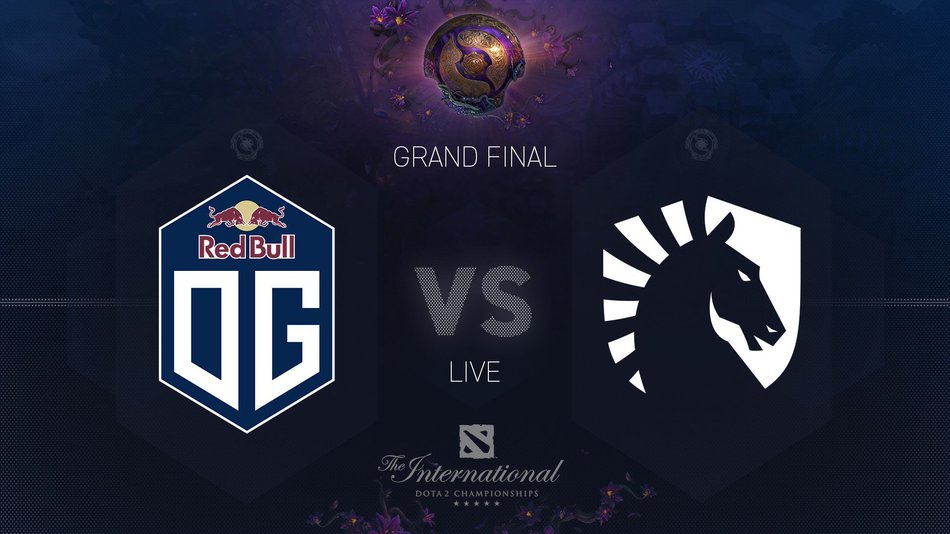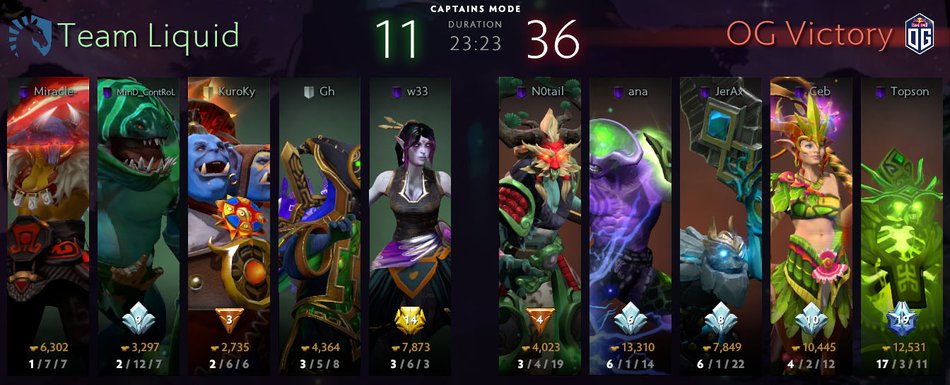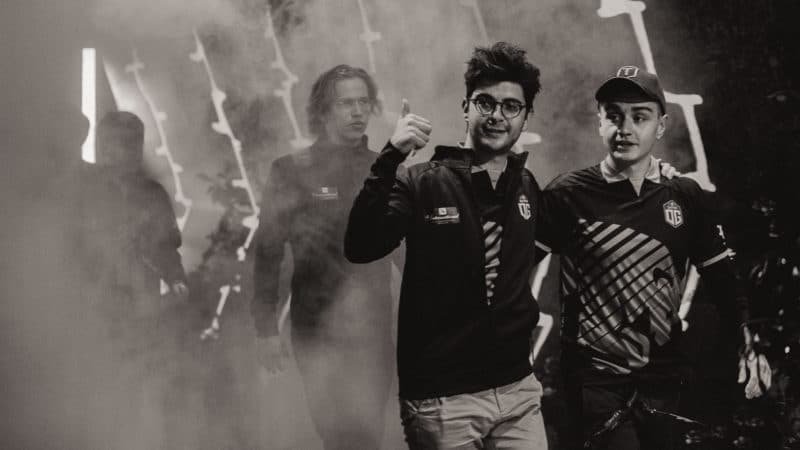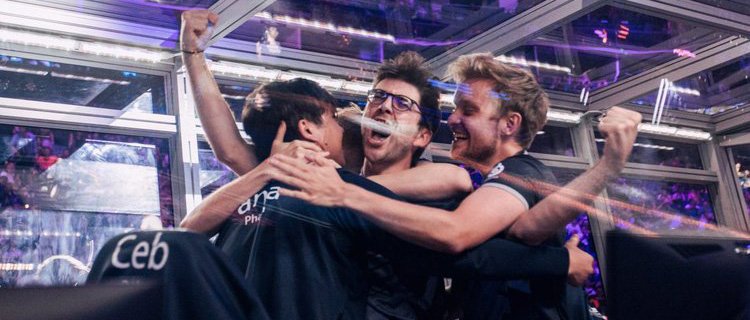- English
- Русский
I am certain anyone following competitive Dota for a while has a profound feeling we just witnessed something special and deeply valuable. Not only in the context of the game and the competition, but in the context of human life in general.
OG’s achievement cannot be overstated – they stand on a summit no other team has ever managed to conquer. Holding the Aegis of Champions two times in a row is an incredible feat in any context.
Yet, what makes their story transcend beyond the realm of Dota is that they were triumphant while representing the deep human values of friendship, loyalty, trust, creativity, and humility.
OG are the champions of our community not only because they are the best Dota players. They are our champions because they embody the very best values this game can bring out of us all.
This is the last installment of the TI9 Meta series. I most certainly don’t claim to have complete understanding of the amazing games that the teams played for us. I believe, however, that it’s very interesting to try to delve into the strategic details to fully appreciate the ingenuity of the people pouring their heart and soul into the game.
While this article is about OG, it takes two to tango. I’ll start with the losers bracket finals because I believe there is a very interesting and significant continuity between the two series.
I think the LGD vs Liquid games showcased very visibly how big of a role faith plays in drafting and how it can win and lose games:

In game 1, both teams started with a non-surprising meta opening and completed a well-rounded draft out of it. Liquid had Void (the best performing pos. 1 hero on the main stage) and decided to combine it with W33’s Tinker. Tinker is off-meta right now, but they had played it before, and Tinker is quite synergistic with Void.
LGD, however, used the fact that they had last pick brilliantly: they moved Gyro to the mid lane and drafted Specre, who is a hard counter to Tinker. Moreover, Liquid lacked the tools to heavily pressure the Spectre early on in their lineup as Void and Tinker are not very aggressive cores. Tinker needs time to farm, while Void is restricted by the long CD on Chrono.
The game finished as planned for LGD - Spect managed to carry them to victory. What was unexpected, however, was how great Centaur did in this game. Even after a very rough 0-3 start, he was able to come back and even was the highest net worth hero in the early-mid game, which helped him have an extremely high impact.
This gave LGD a lot of faith in the Centaur pick, so in game 2 they first-picked it for Chalice:
In the second game, Liquid gave W33 Templar Assassin as the last pick for their team – a hero he’s been quite successful on in this tournament and a good counter to Life Stealer, who lacks the tools to remove Refraction and is vulnerable to armor reduction.
LGD tried to use their last pick in the same way they did in the first game – by picking a direct counter to one of the center-pieces of Liquid’s draft. Huskar was supposed to counter W33’s TA and win LGD the series.
Things, however, didn’t go as planned. LGD’s aggressive draft was slowly building up a significant resource advantage, but they didn’t manage to finish the game fast enough, Huskar fell-off, and Liquid managed to claim the victory in the late game with their better-scaling cores.
The fact that Liquid won a game with TA when she was “hard-countered” gave Liquid a lot of faith in the hero and in the next game they drafted her as a 2nd pick, theoretically giving LGD a lot of time to try to counter her again.
TA is a snowballing semi-carry. She wins her lane, gets her core items, hits a very strong mid game timing (Deso, Blink, BKB), and ideally takes map control, Rosh, and the game.
The theory behind countering her with Huskar is that he will destroy her in the lane, which would not allow her to snowball and hit her timing. This would reduce her overall impact a great deal. (Burning Spears counter her Refraction directly - they remove the charges. Moreover, she has short range, so it’s very hard for her to take last hits without getting constantly harassed.)
TA, however, is actually not as reliant on winning the mid matchup as she once was. She actually finds most of her farm in the jungle – her AoE attacks and high damage help her clear stacks very efficiently, so even if Huskar beats her in the lane, she can recover in the jungle quite quickly and still have a decent impact in the game.
To top it off, TA has good talents that make her better in the late game than she once was. This means that she isn’t as reliant on winning the game during her mid-game timing and she is quite comfortable going late (she certainly can out-scale the Huskar, who is even vulnerable to her nuke damage.)

So, the outcome of game 2 gave Liquid the confidence to draft TA as a 2nd pick. What worse can they throw at her than Huskar?
LGD went back to a lot of comfort picks for their last game (most notably Somnus SF and FY Rubick), but this time around it was Liquid who used the last few picks in the draft brilliantly. Winter Wyvern was an underused hero this TI, but Cold Embrace is a hard counter to Void’s Chronosphere. Moreover, the long-range Winter’s Curse is a great setup for Ravage (a devastating team-fight combo we managed to see). To top it off, Liquid got their hands on a last-pick Wraith King. After Mineski and Infamous dropped out of the tournament, Wraith King stopped being as highly contested, so he managed to slip through without getting banned. WK is great against Chrono and the nuke damage of SF - if LGD’s cores blow all of their cooldowns on WK’s first life, they wouldn’t have the resources to kill him a second time.
The plan worked out, and Liquid managed to claim the series to the immense disappointment of 18k Chinese fans in the arena.

So, by the end of the loser bracket finals, Liquid had two wins with TA. One versus a last-pick hard counter (Huskar), and one where they 2nd picked the hero. Needless to say, the team acquired a lot of faith in TA in this meta.
Moreover, in game 3 vs LGD, Liquid claimed another convincing victory with Tide, giving them a flawless 5-0 record with the hero. As a consequence, TA + Tide became a pivotal part of their grand finals strategy.
Being very confident in those two picks played a big role but sadly for Liquid – not a positive one.

In game one, Liquid used the fact that they have last pick to get a win with Meepo.
Meepo was Liquid’s checkmate (cheesy) last-pick which they had successfully used this TI and he fit the game very well: OG had decided to give Ana’s hard carry Spect a try, and Meepo counters Spectre’s slow tempo very well. He out-farms her severely, takes over the map (leaves Spect little space to farm), and breaks the base before she is able to come online.
Even though Liquid won the game, it certainly didn’t go as planned. OG were able to stall the game for a long time and Spect reached the breaking point in which Meepo was no longer the strongest hero on the map and OG were ready to secure the victory.
After a misplay on their part, however, Liquid used TA + Meepo’s very high building damage to run down the mid lane and evaporate OG’s Ancient. OG were too slow to react and lost a game they had a firm grasp on.
This game was all about the Meepo strat versus the Spect strat, so it’s unlikely that Tide and TA’s impact came into question. It seems they did their part adequately, so Liquid preserved their confidence in the two picks.
Consequently, in game two, Liquid opened up with Tide + TA as their first two picks.
OG, however, had a very different approach to countering TA and Tide than LGD.

You wouldn’t traditionally think of a Lifestealer + TA + Tide lineup as a slow lineup. In fact, all three cores have a very strong mid-game timing.
In the early game, however, Liquid actually has a slow and passive draft.
As we already mentioned, TA wants to spend the early game farming the jungle until she has a few core items. She wants to fight after she has farmed Deso + Blink, and ideally even BKB.
Tide isn’t aiming for an item timing (although the utility items certainly help), but what restrains his aggression is the huge CD on Ravage. He can afford to play aggressively with Ravage, but once the spell is on CD, he usually also wants to use Anchor Smash to farm waves and camps.
Lifestealer doesn’t have a big CD and he can certainly be played aggressively, but the meta pos. 1 Lifestealer goes for Midas and usually likes to farm undisturbed until he gets Radiance.
Last but not least, Liquid have a pos. 4 Enigma. As we all know, a dedicated jungler makes your lanes weaker. Moreover, like Tide, Enigma likes to play around an ultimate with a big CD. Finally, Enigma also needs items to fight comfortably. A long-duration Black Hole is almost impossible without BKB versus a good team.
So, OG countered Liquid’s lineup by drafting a team with a much, much higher tempo.
None of OG’s cores needs expensive items to start fighting. Ember just needs lvl6 and a high-enough level in his other spells to start searching for kills. Monkey King is essentially created to run at heroes thanks to Jingu Mastery, and all he needs to succeed is some control from his teammates. Their position 4 hero, the Tiny of Jerax, is the opposite of what Liquid have. While Enigma wants to farm, all a pos. 4 Tiny wants to do is to play aggressively and attempt to get kills. It also certainly helps that Omni is there to protect his teammates with his spells when they decide to play overly-aggressive.
Besides the tempo of the whole draft, OG also had very good direct hero matchups. Ember is a decent laner against Tidehunter – Anchor Smash deals physical damage, so it cannot be used to remove Ember’s Flame Guard. This means Ana can use it to continuously damage Mind Control in the lane. Moreover, Grimstroke is very useful versus Tide, because Kraken Shell cannot dispel Grimstroke’s Silence (Phantom’s Embrace). Finally, OG has Omni to counter Lifestealer and TA’s high physical damage output in fights.
By playing extremely aggressively, OG completely dismantled Liquid.
(Strategy aside, there is a lot to be said about OG’s execution, but more on that below.)

Game 3 was, IMO, the pivotal game in this series. This was the game in which Liquid should have concluded that OG know how to deal with Tide + TA. This was also the game in which they should have tried as hard as possible to deal with the problems of game 2 - to secure a great start of the game to prevent OG from playing as aggressively as they did in game 2.
Liquid, however, drafted Tide + TA once again. Instead of Lifestealer, they went with Jugg, but Jugg is a similar hero to Lifestealer in terms of tempo and doesn’t make Liquid’s overall strategy very different. They didn’t have a support Enigma this time around, but it didn’t make a huge difference.
OG used different heroes but the same ideas as in game 2. They played an extremely high tempo game to break Liquid before they are able to hit their timings.
This time the main drivers of the high tempo were offlane Enchantress who is very capable of constant pressure right from the start of the game (one of the most feared heroes in the whole tournament), roaming Tiny once again, and a new brilliant last pick – pos. 2 Pugna. Pugna is quite decent versus TA in the lane thanks to Decrepify. The spell is also a very good defensive mechanism versus TA’s physical burst damage and Jugg’s Omnislash.
The key, however, is that after winning the lane, Pugna is one of the best tower-pushers in the game. This meant that each successful aggressive move from OG cost Liquid objectives and a lot of map control, which lead to a 2nd 20-minute victory in a row from OG (and one of the best performances on Pugna we’ve ever seen from Godson).
By the end of game 3, Liquid were finally aware that Tide + TA wasn’t working out for them. The problem was they had only one game to try out something different.
It was obvious that OG were demolishing them in the early game, so the logical thing was to make sure they don’t lose the lanes. They left Tide + TA to the side, and opened up with Omni + Chen – two heroes who can deal with early-game pressure much better.

They left Io out of the bans, probably because they had confidence they have a chance to counter it after successfully countering Secret’s carry Io strat.
They beat Secret’s carry Io with Meepo, but OG wisely banned Meepo in the 2nd ban phase, so Liquid had to think of something else.
One of the reasons why Meepo is theoretically good versus a carry Io strat is because he hits his timing before Io. A pos. 1 Bristleback with two healers behind him (Chen + Omni) might have a similar effect. He is able to fight from very early on and could possibly break the enemy base before Io is ready. Chen + Omni will make him nearly immortal with the heals, but also with a Pipe and the magic resistance auras from creeps that Chen can convert and bring with the team (Io mainly deals magic damage with his Balls and Aghs).
As we know, things didn’t go as planned. Topson’s Gyro proved to be a big problem, Liquid were unable to break the base, and once Io hit his Agh’s + lvl15 timing (and Gyro got Diffusal), OG took the game, the series, and the Aegis of Champions.
A lot of people are saying that letting OG pick Io was an obvious mistake, but in a way, Liquid had to try to beat it. There are simply not enough bans to get rid of all of OG’s strategies. The problem was, however, that this game was an elimination game for them. IMO, a quicker realization that they need to change something fundamentally after game 2 would have given Liquid at least one more game to try to figure OG out. For example, something they didn’t have a chance to try was to let through OG’s late game strats (Magnus) while banning OG’s high-tempo heroes. There is no guarantee that this would have worked and the series could have still ended 3-1 for OG, but at the same time one more attempt to figure them out is insanely valuable and it could have made the series more competitive.
Watching game 2 and 3, it felt like pro Dota has gone a full circle.
In a conversation with Puppey a long, long time ago (before TI3) he mentioned that one of the biggest innovations of pro Dota was the realization that objectives are way more important than kills. In fact, his main role in the old Na’Vi team was to control the tower-diving davai spirit of the CIS players and to make sure that every aggressive move they make leads to objectives and map control.
In game two of TI9’s grand finals, however, OG were diving the enemy base when the enemy T1 towers were still standing, which seems to run contrary to the every basic principle we know about Dota.
The individual play of everyone on the team was top-tier, but it seemed that this is not the key to their success in this seemingly insane playstyle. They still made mistakes and died every once in a while, but this didn’t seem to shift the momentum too much.
I believe there are two main factors that make this possible:

Not a stock photo, but OG during the draft.
OG are fully consciously aware of the timings in the game. They know when their team is strong, and when the enemy team is weak. The easiest example is the Io Agh’s + lvl15 talent timing: regardless if they are ahead or behind, they know that they are strong and they start playing aggressively to take control of the game when they hit it.
The same rule fully applies to game 2 and 3 of the grand finals. Even though the laning stage isn’t even over yet, they know Liquid need more space and time to come online while their own lineup doesn’t. Because of this, they are comfortable to start playing hyper-aggressively far earlier than anyone anticipates them to. To make sure they use their advantage to its fullest potential, the pressure never relents even after the occasional misplay and death (dying once doesn’t mean your timing window is over just yet).
In game 2, they dove behind all possible towers simply because they had terrible tower push, and diving was the only way to continue applying pressure during their timing window. Taking risks and diving towers was a way better option than playing safe and letting Liquid’s cores farm their jungle undisturbed. In game 3, thanks to Pugna, they still played hyper-aggressively, but managed to take objectives along with the kills.

The
second and arguably the most important part of being able to play this
aggressively successfully is complete trust in your teammates:
For example, when you play Omni together with a tower-diving core, you become extremely aware of just how short-range the spells of this hero are. There is no way to play safe with Omni when your core wants to play aggressive. Often in pubs, if you’re uncertain the aggressive playstyle is the right thing to do (i.e. you don’t trust your core), this would lead to miscommunications and deaths. Ceb, however, managed to always be in range to help out his teammates, even when they were diving towers T2 towers at 10 minutes in like madmen.
The same applies to other more unusual situations. 1v1 mid matchups tend to be quite clinical in Dota. Two heroes try to out-play each other for last-hits and harass. The only thing that disrupts this is the occasional gank rotation by the supports, but even this interruption is temporary. When your position 4 Tiny stays in the mid lane for extended periods of time and chases the enemy hero behind the tower Tossing him around like a Basketball, however, the usual 1v1 mid situation flies out the window. Topson, however, seemed to be quite comfortable in this strange state of affairs and was able to trust Jerax and match his aggression very well, which led to a big advantage for OG. The two players were able to play off each other very well and the enemy midlaner was miles away out of his comfort zone.
In
a nutshell, as N0tail himself said – “everything can work in Dota”. If you have
a clear idea about what you need to do and if you fully trust in the decisions
of your teammates (this means to continue trusting in them even if their ideas
occasionally don’t work out), the result could be quite beautiful.
The Dota that Liquid, LGD, and most teams in the world are playing certainly looks more understandable and clinical than what OG are doing. That’s why everyone on the broadcast team liked the idea that Liquid are approaching Dota as a science, while OG – as art.
The team that managed to give me a similar feeling when I was watching them play were TI6 Wings. While Wings were able to make this impression mainly with their insane drafts, OG (who have equally insane but less diverse drafts) are able to give this feeling with their play as well.
Calling them the best team of all time is certainly easy with their two consecutive championships. In my opinion, however, they deserve this title also because of the level of Dota they showcased at this TI. It felt like they are a few levels above everyone else both strategically (knowledge) and in terms of team play and execution (trust).
OG certainly raised the bar a lot and showed that things are possible in Dota none of us have ever imagined.

I hope their incredible example
manages to inspire a lot of us to chase our dreams and to try to find the next level in whatever we are
doing. Equally importantly - to remain humble, and to try
to be good people along the way!
Thanks you for reading! It was an absolute pleasure covering this TI and I hope some of you found my articles insightful or at the very least - interesting.
If you are one of these people, give us a follow on our social media (below) to stay in touch when we post something new!